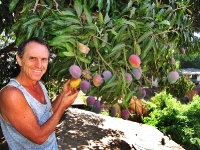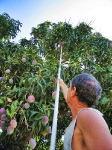![]() Three years ago, we started two projects: getting some greenery along the new white fence out our kitchen window and planting a vegetable garden. Our efforts were documented on a past gardening web page. (You can look at the photos on that page to see how empty the ground looked around the cottage.) As I commented in that page, between the salt air and the Kihei bugs, we gave up on vegetable gardening and have migrated to the flowering plants. With great satisfaction, our efforts have paid off with lush greenery and lovely flowers around our home.
Three years ago, we started two projects: getting some greenery along the new white fence out our kitchen window and planting a vegetable garden. Our efforts were documented on a past gardening web page. (You can look at the photos on that page to see how empty the ground looked around the cottage.) As I commented in that page, between the salt air and the Kihei bugs, we gave up on vegetable gardening and have migrated to the flowering plants. With great satisfaction, our efforts have paid off with lush greenery and lovely flowers around our home.
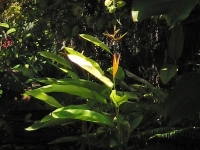 We enjoy the vibrant green of our back garden under the spreading branches of our favorite mango tree. It is filled with golden torch heliconia, ferns, blue ginger, and indian head ginger bushes. Farther back are two lilikoi (passion fruit) plants with vines creating a canopy where they can reach more sun. Fortunately it’s a low maintenance garden requiring occasional weeding and raking out the fallen mango leaves!
We enjoy the vibrant green of our back garden under the spreading branches of our favorite mango tree. It is filled with golden torch heliconia, ferns, blue ginger, and indian head ginger bushes. Farther back are two lilikoi (passion fruit) plants with vines creating a canopy where they can reach more sun. Fortunately it’s a low maintenance garden requiring occasional weeding and raking out the fallen mango leaves!
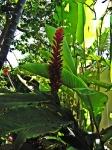 I am proud that the red ginger flowers have done so well out the kitchen window. And in addition to the flowers, we enjoy watching the numerous gekos and anole lizards sunning themselves and racing after insects. I can’t believe how the heliconia have taken off. Not only have they grown tall and colorful, they have spread to dominate the back half of the garden and continue to try to spread out into the small path. Every few weeks I need to dig out the starts in the path and work to find a place to replant them in the contained border. Plus I cut out the stocks that have finished with their blooms and are starting to turn brown. The purple flower Mexican Petunia plants are also in continual flower. They open new blossoms every morning and the wind blows them off every afternoon.
I am proud that the red ginger flowers have done so well out the kitchen window. And in addition to the flowers, we enjoy watching the numerous gekos and anole lizards sunning themselves and racing after insects. I can’t believe how the heliconia have taken off. Not only have they grown tall and colorful, they have spread to dominate the back half of the garden and continue to try to spread out into the small path. Every few weeks I need to dig out the starts in the path and work to find a place to replant them in the contained border. Plus I cut out the stocks that have finished with their blooms and are starting to turn brown. The purple flower Mexican Petunia plants are also in continual flower. They open new blossoms every morning and the wind blows them off every afternoon.
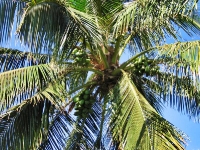 We have a ficus tree that has grown so huge and spread its branches so wide you would think it wants to be the Lahaina banyan tree. And we are love having so many coconuts and palm trees on the property. But we have to be careful about where we park as sometimes the coconuts have grown pretty large and can do some real damage to a car or a head!
We have a ficus tree that has grown so huge and spread its branches so wide you would think it wants to be the Lahaina banyan tree. And we are love having so many coconuts and palm trees on the property. But we have to be careful about where we park as sometimes the coconuts have grown pretty large and can do some real damage to a car or a head!





















